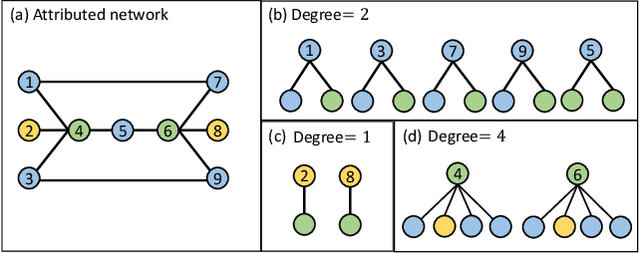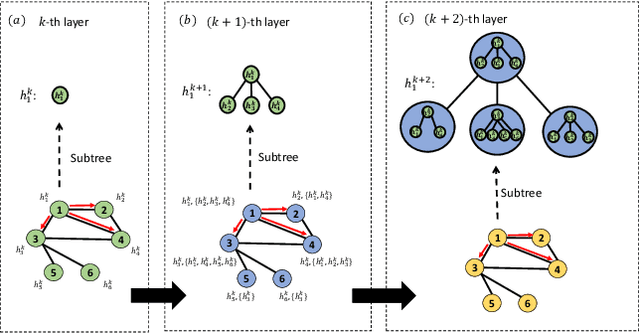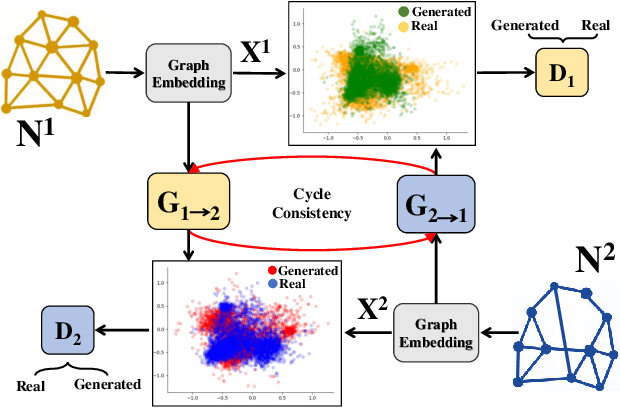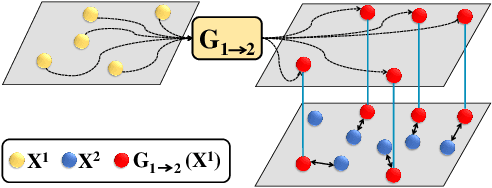Jiejun Xu
Neural Multi-network Diffusion towards Social Recommendation
Apr 11, 2023Abstract:Graph Neural Networks (GNNs) have been widely applied on a variety of real-world applications, such as social recommendation. However, existing GNN-based models on social recommendation suffer from serious problems of generalization and oversmoothness, because of the underexplored negative sampling method and the direct implanting of the off-the-shelf GNN models. In this paper, we propose a succinct multi-network GNN-based neural model (NeMo) for social recommendation. Compared with the existing methods, the proposed model explores a generative negative sampling strategy, and leverages both the positive and negative user-item interactions for users' interest propagation. The experiments show that NeMo outperforms the state-of-the-art baselines on various real-world benchmark datasets (e.g., by up to 38.8% in terms of NDCG@15).
FairGen: Towards Fair Graph Generation
Mar 30, 2023Abstract:There have been tremendous efforts over the past decades dedicated to the generation of realistic graphs in a variety of domains, ranging from social networks to computer networks, from gene regulatory networks to online transaction networks. Despite the remarkable success, the vast majority of these works are unsupervised in nature and are typically trained to minimize the expected graph reconstruction loss, which would result in the representation disparity issue in the generated graphs, i.e., the protected groups (often minorities) contribute less to the objective and thus suffer from systematically higher errors. In this paper, we aim to tailor graph generation to downstream mining tasks by leveraging label information and user-preferred parity constraint. In particular, we start from the investigation of representation disparity in the context of graph generative models. To mitigate the disparity, we propose a fairness-aware graph generative model named FairGen. Our model jointly trains a label-informed graph generation module and a fair representation learning module by progressively learning the behaviors of the protected and unprotected groups, from the `easy' concepts to the `hard' ones. In addition, we propose a generic context sampling strategy for graph generative models, which is proven to be capable of fairly capturing the contextual information of each group with a high probability. Experimental results on seven real-world data sets, including web-based graphs, demonstrate that FairGen (1) obtains performance on par with state-of-the-art graph generative models across six network properties, (2) mitigates the representation disparity issues in the generated graphs, and (3) substantially boosts the model performance by up to 17% in downstream tasks via data augmentation.
DEMO-Net: Degree-specific Graph Neural Networks for Node and Graph Classification
Jun 05, 2019



Abstract:Graph data widely exist in many high-impact applications. Inspired by the success of deep learning in grid-structured data, graph neural network models have been proposed to learn powerful node-level or graph-level representation. However, most of the existing graph neural networks suffer from the following limitations: (1) there is limited analysis regarding the graph convolution properties, such as seed-oriented, degree-aware and order-free; (2) the node's degree-specific graph structure is not explicitly expressed in graph convolution for distinguishing structure-aware node neighborhoods; (3) the theoretical explanation regarding the graph-level pooling schemes is unclear. To address these problems, we propose a generic degree-specific graph neural network named DEMO-Net motivated by Weisfeiler-Lehman graph isomorphism test that recursively identifies 1-hop neighborhood structures. In order to explicitly capture the graph topology integrated with node attributes, we argue that graph convolution should have three properties: seed-oriented, degree-aware, order-free. To this end, we propose multi-task graph convolution where each task represents node representation learning for nodes with a specific degree value, thus leading to preserving the degree-specific graph structure. In particular, we design two multi-task learning methods: degree-specific weight and hashing functions for graph convolution. In addition, we propose a novel graph-level pooling/readout scheme for learning graph representation provably lying in a degree-specific Hilbert kernel space. The experimental results on several node and graph classification benchmark data sets demonstrate the effectiveness and efficiency of our proposed DEMO-Net over state-of-the-art graph neural network models.
Deep Adversarial Network Alignment
Feb 27, 2019



Abstract:Network alignment, in general, seeks to discover the hidden underlying correspondence between nodes across two (or more) networks when given their network structure. However, most existing network alignment methods have added assumptions of additional constraints to guide the alignment, such as having a set of seed node-node correspondences across the networks or the existence of side-information. Instead, we seek to develop a general network alignment algorithm that makes no additional assumptions. Recently, network embedding has proven effective in many network analysis tasks, but embeddings of different networks are not aligned. Thus, we present our Deep Adversarial Network Alignment (DANA) framework that first uses deep adversarial learning to discover complex mappings for aligning the embedding distributions of the two networks. Then, using our learned mapping functions, DANA performs an efficient nearest neighbor node alignment. We perform experiments on real world datasets to show the effectiveness of our framework for first aligning the graph embedding distributions and then discovering node alignments that outperform existing methods.
 Add to Chrome
Add to Chrome Add to Firefox
Add to Firefox Add to Edge
Add to Edge